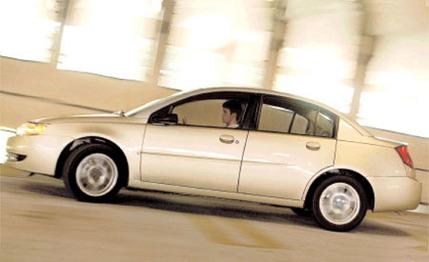First Drive Review
Saturn has only been building cars since 1990, which doesn't seem long, but it seems as if the Saturn coupe has been with us forever. We suppose that's because age can be a plus to a business entity - stay alive long enough (we exclude Oldsmobile), and the years add up to a totem of experience, wisdom, and savvy. But that's a distinct liability for a product, especially one that's competing in an environment of relentless renewal.
From that perspective, the replacements for the original Saturn coupes and sedans are long overdue - sufficiently overdue, in fact, that the Saturn marketing honchos apparently perceived the old alphanumeric model designations as a liability. So they discarded some of them and substituted a name - Ion - which, as we all know, has something to do with electricity and is therefore very mysterious. (The name has, predictably, inspired Saturn publicists to all sorts of electrically charged flights of fancy, such as this headline: "All-New Saturn Ion Sedan and Quad Coupe Designed to Reenergize Small-Car Segment.")
Paring away the hyperbole, there is at least one unassailable nugget of truth in that head: all-new. Saturn retains the element that helped to make the originals a hit: Most of the cars' vertical body panels - doors, fenders, bumpers - are plastic, making them owner-friendly for such activities as shopping-cart polo, parking by Braille, and back-stopping softball games. Everything else is new. The new "architecture" (GM-speak for the car's platform), code name Delta, is shared with the Opel Astra and soon will support the next-generation Chevy Cavalier and Pontiac Sunfire. New powertrains. New shapes. New interiors. Even a couple of new ideas, one of which works, one of which needs work.
The '03 Ion "quad coupe" (named for one of those new ideas) that rolled off the transporter onto our Hogback Road parking lot back in July looked familiar, and for good reason - we last saw it at April's New York auto show, where the Ion made its first public appearance. So even though the car was turntable pretty, with the same carbon-fiber-look trim pieces, and was fully functional, it was far from showroom ready, which meant delaying any driving impressions until we plant our backsides in something a little more representative of production.
Even so, our first Ionization provoked a number of observations, to wit:
- Saturn introduced the third-door concept - a driver's-side rear-hinged (please refrain from saying suicide) demi-door on the SC1 and SC2 - four years ago. It was an excellent idea. The Ion quad coupe (meaning all Ion coupes) has rear-hinged rear doors on both sides, which is an even better idea. The rear doors swing out almost 90 degrees, making rear-seat access far easier than worming one's way into the back seat of a conventional two-door car.
- The Ion's instrument binnacle sits atop the center of the dashboard, squarely amidships. Saturn designers say this is better because the driver doesn't have to worry about the steering wheel blocking his or her view of the instruments and because it's less distracting to scan the instruments by glancing to the right, rather than down. We didn't buy into this rationale with the Toyota Echo. We don't buy into it here, either.
- All Ions will be powered by GM's Ecotec engine, a 2.2-liter DOHC 16-valve four rated at 140 horsepower and 142 pound-feet of torque. Destined for more-widespread use in GM vehicles, this all-aluminum engine is more powerful and distinctly smoother (thanks to twin balance shafts) than Saturn's buzzy old home-grown 1.9-liter fours, which have been scrapped.
- The standard transmission for Ions will be a five-speed manual. There are two automatics: a continuously variable unit - VTi (variable transmission with intelligence) in Saturn parlance - that was first introduced in the Saturn Vue sport-utility and a conventional five-speed automatic (offered only in sedans).
- As to performance, we anticipate smoother, quieter operation, but it's not clear that the Ions will be significantly quicker than their predecessors, despite the horsepower advantage (16 more than the old twin-cam, 40 more than the old SOHC). Although the Ecotec is better in every way, it's towing bigger cars, about 400 pounds more than the previous models, according to factory specs. As a result, power-to-weight ratios between old twin-cammers and the new cars are very close, and we'll be surprised if the Ion coupe sprints to 60 in much less than 8.0 seconds.
- Bigger - 4.5 inches longer, 3.0 inches taller (on a 103.2-inch wheelbase, up 0.8 inch) - equates with roomier. The Ion coupe boasts a 93-cubic-foot EPA passenger-volume rating, versus 84 for its predecessor. Sedans grow similarly, gaining two cubic feet inside. Trunk volume - 14.5 cubes - stacks up as best in class. And unlike in most small coupes, the rear seat is actually usable. By adults. Briefly.
- Dynamics: With an all-new body shell, the Ion quad coupe figures to be structurally stiffer than the SC, and stiffness is the cornerstone of good handling. However, the design team discarded the previous all-independent strut-suspension setup for a beam axle at the rear to cut costs and gain cargo space.
- Price. As we went to press, Saturn would say only that it will be very close to current S-series numbers. Base prices for 2002 models range from $11,035 to $13,890 for the sedans and from $13,455 to $16,635 for the coupes. Ion sedans go on sale mid-month, coupes shortly after the first of the year.

 First Drive Review
First Drive Review